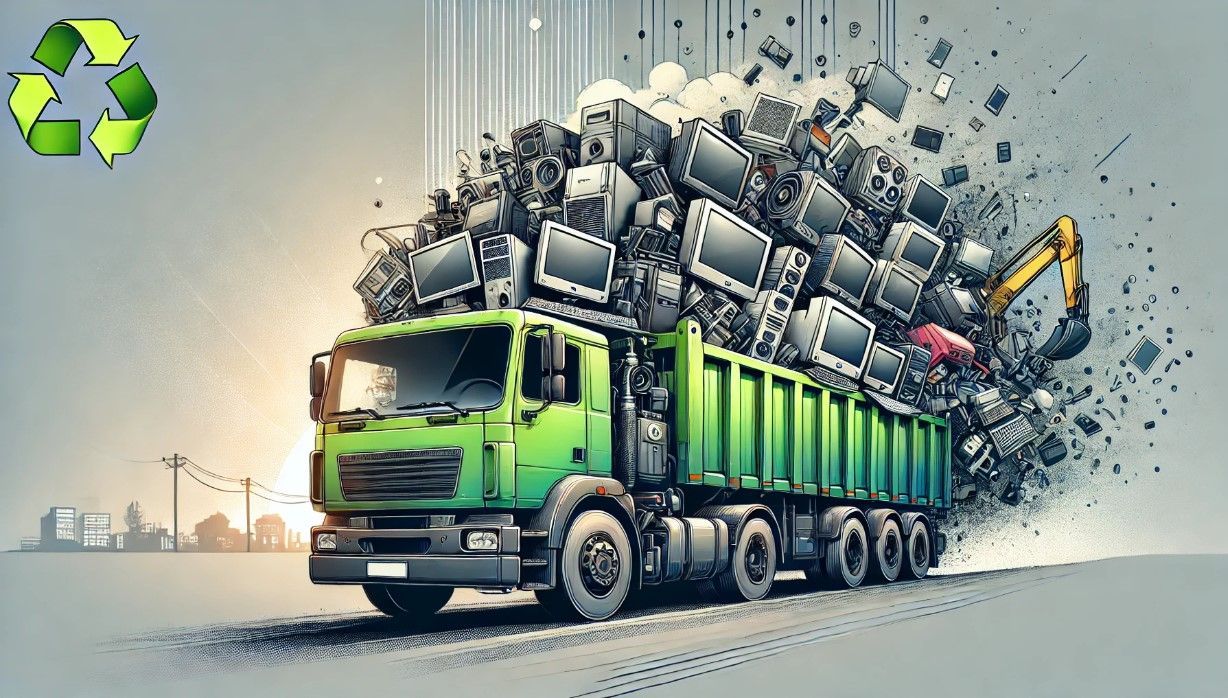
E-Waste Recycling Service: A Complete Guide to Sustainable Electronics Disposal
The growing reliance on electronic devices has led to a significant increase in electronic waste, or e-waste. Proper e-waste recycling is not only crucial for environmental sustainability but also essential for data security and compliance with local laws. In this guide, we’ll explore why e-waste recycling matters, the best methods to dispose of your electronics, and how you can contribute to a greener planet.
What is E-Waste, and Why Should You Care?
E-waste includes discarded electronic devices like smartphones, computers, televisions, and other gadgets. These devices often contain hazardous materials such as lead, mercury, and cadmium, which can harm the environment and human health if not disposed of properly. Moreover, e-waste can contain sensitive data that could be at risk if not handled correctly.
Key Points to Remember:
- E-waste includes any electronic devices no longer in use.
- Hazardous materials in e-waste can pollute the environment.
- Proper recycling helps recover valuable materials like gold and silver.
The Environmental Impact of Improper E-Waste Disposal
When e-waste is not recycled correctly, it often ends up in landfills or is improperly incinerated. This leads to severe environmental issues, including:
- Soil Contamination: Toxic substances from e-waste can seep into the ground, affecting soil and water quality.
- Air Pollution: Burning e-waste releases harmful chemicals into the air, contributing to air pollution and respiratory problems.
- Water Pollution: Heavy metals from e-waste can leach into water bodies, posing risks to aquatic life and human health.
By recycling e-waste, you can help reduce these environmental hazards and promote the recovery of valuable materials, reducing the need for new resource extraction.
How to Recycle E-Waste Responsibly
Recycling e-waste is not just about dropping off old gadgets at a recycling center. Here’s a step-by-step guide to ensure your e-waste is handled correctly:
1. Identify What Can Be Recycled:
- Most electronics, including computers, phones, and TVs, are recyclable.
- Check with your local recycling program to see what items they accept.
2. Backup and Wipe Data:
- Backup: Before recycling, ensure you back up all important data.
- Data Wipe: Use data-wiping software to securely erase all personal information from devices. This protects you from identity theft and data breaches.
3. Find a Certified E-Waste Recycler:
- Look for recyclers certified by organizations like e-Stewards or R2. These certifications ensure that recyclers follow ethical and environmentally sound practices.
- Avoid e-waste recycling events that do not specify how the waste will be processed.
4. Understand Local E-Waste Recycling Laws:
- Regulations on e-waste recycling can vary significantly by location. Some areas require manufacturers to take back old electronics, while others offer municipal recycling programs.
- Check your local government’s website for specific guidelines.
Frequently Asked Questions About E-Waste Recycling
Q1: Can I just throw my old electronics in the trash? No, disposing of electronics in the trash is illegal in many places due to the hazardous materials they contain. Always recycle e-waste through proper channels.
Q2: How can I ensure my data is safe during recycling? Use reputable data-wiping software or consider professional data destruction services to ensure your data is completely erased before recycling.
Q3: What should I do with accessories like chargers and headphones? Many recycling programs accept accessories, but check with your local program first. Some items like batteries may need to be disposed of separately.
The Role of E-Waste Recycling Services
E-waste recycling services provide a critical function by offering safe, environmentally friendly disposal options for old electronics. These services often include:
- Drop-off Locations: Convenient spots where you can leave your electronics for recycling.
- Pickup Services: Many recyclers offer pickup services for large quantities of e-waste, which is ideal for businesses.
- Data Destruction: Professional services to ensure all data is securely erased, providing peace of mind for businesses and individuals.
Choosing a Reliable E-Waste Recycling Service:
- Certification: Ensure the service is certified and follows local regulations.
- Transparency: Look for services that provide detailed information about their recycling process.
- Customer Reviews: Check reviews to gauge the reliability and quality of the service.
Creating an E-Waste Recycling Plan for Your Business
Businesses often generate significant amounts of e-waste. Implementing a structured e-waste recycling plan can help ensure compliance with regulations and promote sustainability.
Steps to Develop a Plan:
- Audit Your E-Waste: Identify all electronic devices and accessories that need disposal.
- Choose a Certified Recycler: Partner with a recycler that offers comprehensive services, including pickup and data destruction.
- Establish a Schedule: Regularly review and recycle e-waste to prevent accumulation.
- Educate Employees: Train staff on the importance of e-waste recycling and the company’s specific procedures.
A Look into the Future of E-Waste Recycling
The future of e-waste recycling is promising, with technological advancements making recycling processes more efficient and less costly. Innovations include:
- Automated Sorting: Machines that can sort different materials quickly, reducing labor costs and improving accuracy.
- Advanced Data Destruction: Enhanced methods to ensure complete data security, catering to growing concerns over privacy and data breaches.
- Upcycling: Creative repurposing of e-waste materials into new products, reducing waste and fostering innovation.
Encouraging Reader Interaction
How do you handle your e-waste? Share your tips in the comments below! If you found this guide helpful, consider sharing it on social media to help spread the word about responsible e-waste recycling.
By keeping your e-waste out of landfills and ensuring it is recycled responsibly, you contribute to a healthier planet and a safer community. Let’s all do our part to manage electronic waste effectively!
E-Waste Recycling Table: Quick Reference Guide
| Item | Recycle | Dispose of Separately | Data Security Tip |
|---|---|---|---|
| Smartphones | Yes | No | Use factory reset + data wipe software |
| Laptops | Yes | No | Remove and destroy hard drive if possible |
| Batteries | No | Yes | N/A |
| Monitors | Yes | No | N/A |
| Printers/Scanners | Yes | No | Remove ink cartridges first |
| Headphones | Yes | No | N/A |
Remember, keeping your e-waste recycling up-to-date ensures compliance with local regulations and reduces your environmental footprint. Regular updates to your recycling habits can keep you informed of new laws and technologies that improve the recycling process.
Furniture Removal
Appliance Removal
Other Services
- Hot tub Junk Removal
- Dumpster Rentals
- Shed Junk Removal
- Hoarder house Cleanouts
- House Junk Removal
- Construction Waste Removal
- Garage Cleanouts
- Foreclosure Clear outs
- Eviction Clean outs
- Apartment Cleanouts
- Property Clean outs
- Estate Clean outs
- Hoarding Clean outs
- Yard Waste Removal
- Storage Unit Cleanouts
- Warehouse Cleanouts
- Commercial Junk Removal
OUR SERVICES AND AREAS
- Everett, WA
- Seattle, WA
- Marysville, WA
- Snohomish, WA
- Arlington, WA
- Mukilteo, WA
- Monroe, WA
- Granite Falls, WA
- Bothell, WA
- Whidbey Island, WA
- Stanwood, WA
- Edmonds, WA
Contact us
If you have any questions or need any assistance after business hours, please get in touch.
Phone
BUSINESS HOURS
- Monday
- -
- Tuesday
- -
- Wednesday
- -
- Thursday
- -
- Friday
- -
- Saturday
- -
- Sunday
- Closed
All Rights Reserved | Sno King Junk Removal
